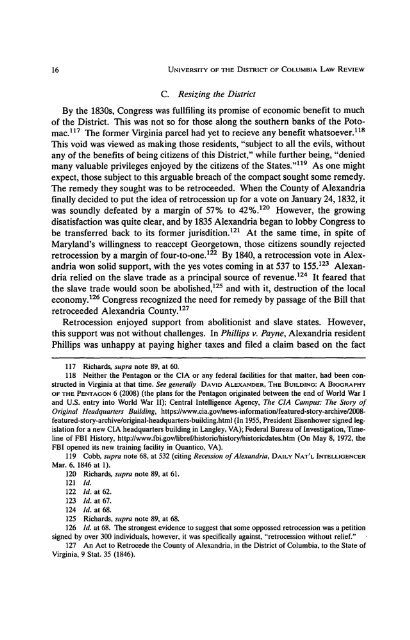Download - UDC Law Review
Download - UDC Law Review
Download - UDC Law Review
You also want an ePaper? Increase the reach of your titles
YUMPU automatically turns print PDFs into web optimized ePapers that Google loves.
16 UNIVERSITY OF THE DISTRlcr OF COLUMBIA LAW REVIEWC. Resizing the DistrictBy the 1830s, Congress was fullfiling its promise of economic benefit to muchof the District. This was not so for those along the southern banks of the Potomac.117 The former Virginia parcel had yet to recieve any benefit whatsoever. 118This void was viewed as making those residents, "subject to all the evils, withoutany of the benefits of being citizens of this District," while further being, "deniedmany valuable privileges enjoyed by the citizens of the States. ,,119 As one mightexpect, those subject to this arguable breach of the compact sought some remedy.The remedy they sought was to be retroceeded. When the County of Alexandriafinally decided to put the idea of retrocession up for a vote on January 24, 1832, itwas soundly defeated by a margin of 57% to 42%.120 However, the growingdisatisfaction was quite clear, and by 1835 Alexandria began to lobby Congress tobe transferred back to its former jurisdition. 121 At the same time, in spite ofMaryland's willingness to reaccept Georgetown, those citizens soundly rejectedretrocession by a margin of four-to-one. 122 By 1840, a retrocession vote in Alexandriawon solid support, with the yes votes coming in at 537 to 155. 123 Alexandriarelied on the slave trade as a principal source of revenue. 124 It feared thatthe slave trade would soon be abolished,125 and with it, destruction of the localeconomy.126 Congress recognized the need for remedy by passage of the Bill thatretroceeded Alexandria County.127Retrocession enjoyed support from abolitionist and slave states. However,this support was not without challenges. In Phillips v. Payne, Alexandria residentPhillips was unhappy at paying higher taxes and filed a claim based on the fact117 Richards, supra note 89, at 60.118 Neither the Pentagon or the CIA or any federal facilities for that matter, had been constructedin Virginia at that time. See generally DAVID ALEXANDER, THE BUILDING: A BIOGRAPHYOF THE PENTAGON 6 (2008) (the plans for the Pentagon originated between the end of World War Iand U.S. entry into World War II); Central Intelligence Agency, The CIA Campus: The Story ofOriginal Headquarters Building, https:llwww.cia.gov/news-information/featured-story-archive/2008-featured-story-archive/original-headquarters-building.html (In 1955, President Eisenhower signed legislationfor a new CIA headquarters building in Langley, VA); Federal Bureau of Investigation, Ttmelineof FBI History, http://www.fbi.gov/libref/historiclhistory/historicdates.htm (On May 8, 1972, theFBI opened its new training facility in Quantico, VA).119 Cobb, supra note 68, at 532 (citing Recession of Alexandria, DAILY NAT'L INTELLIGENCERMar. 6, 1846 at 1).120 Richards, supra note 89, at 61.121 [d.122 [d. at 62.123 Id. at 67.124 Id. at 68.125 Richards, supra note 89, at 68.126 [d. at 68. The strongest evidence to suggest that some oppossed retrocession was a petitionsigned by over 300 individuals, however, it was specifically against, "retrocession without relief:"127 An Act to Retrocede the County of Alexandria, in the District of Columbia, to the State ofVirginia,9 Stat. 35 (1846).














